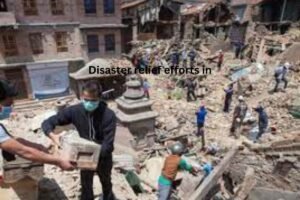Disaster Relief Efforts in Affected Areas
Disasters, whether natural or man-made, leaving behind a trail of destruction and despair. In times of crisis, effective disaster relief efforts are crucial to saving lives, alleviating suffering, and rebuilding shattered communities. From earthquakes to floods, wildfires to pandemics, the response to disasters requires coordinated action and unwavering commitment from governments, NGOs, and volunteers.
Introduction to Disaster Relief Efforts
Disaster relief encompasses a wide range of activities aimed at providing immediate assistance to individuals and communities affected by catastrophes. It involves deploying emergency response teams, distributing food, water, shelter, and medical supplies, and restoring essential services such as electricity and sanitation. The goal of disaster relief is not only to address the immediate needs of survivors but also to facilitate long-term recovery and resilience.
Types of Disasters
Disasters come in various forms, each presenting unique challenges to relief efforts. Natural disasters, including hurricanes, earthquakes, tsunamis, and droughts, are often unpredictable and can cause widespread devastation within minutes. On the other hand, man-made disasters such as industrial accidents, terrorist attacks, and armed conflicts pose complex humanitarian challenges and require specialized expertise and resources.
Key Players in Disaster Relief
Effective disaster relief requires the collaboration of multiple stakeholders, including government agencies, NGOs, international aid organizations, and local communities. Government entities are responsible for coordinating response efforts, mobilizing resources, and implementing disaster management policies. NGOs and humanitarian organizations play a critical role in delivering aid, providing medical care, and supporting vulnerable populations during emergencies.
Challenges in Disaster Relief
Despite concerted efforts, disaster relief operations face numerous challenges that can impede response efforts and hinder the delivery of aid. Limited access to affected areas due to damaged infrastructure, communication breakdowns, and bureaucratic hurdles often delay relief efforts and exacerbate human suffering. Moreover, resource constraints, including funding shortages and supply chain disruptions, pose significant challenges to relief organizations on the ground.

Strategies for Effective Relief Efforts
To overcome these challenges, disaster relief organizations employ various strategies to streamline operations and maximize impact. Coordination and collaboration among stakeholders are essential to ensuring a coherent and efficient response. Pre-positioning of emergency supplies and equipment in strategic locations enables rapid deployment in the aftermath of a disaster. Additionally, engaging local communities in disaster preparedness and response efforts enhances resilience and fosters self-reliance.
Case Studies and Success Stories
Throughout history, numerous examples illustrate the effectiveness of coordinated disaster relief efforts in saving lives and mitigating human suffering. From the earthquake in Haiti to the tsunami in Southeast Asia, communities have demonstrated remarkable resilience in the face of adversity. Lessons learned from past disasters have informed best practices and shaped the evolution of disaster response mechanisms worldwide.
Technology in Disaster Relief
Advancements in technology have revolutionized the field of disaster relief, enabling more efficient and targeted response efforts. Drones and satellite imagery provide real-time data and situational awareness, allowing responders to assess damage and identify priority areas for intervention. Mobile apps and digital platforms facilitate communication, coordination, and information sharing among response teams and affected populations.
Long-term Recovery and Rehabilitation
While immediate relief efforts focus on addressing urgent needs, the journey towards recovery and rehabilitation is a long and arduous process. Beyond rebuilding infrastructure and restoring livelihoods, communities must also address the psychosocial impact of disasters, providing counseling and support to survivors traumatized by loss and displacement. Economic recovery programs and livelihood restoration initiatives are essential to rebuilding communities and restoring hope for the future.
Conclusion
In conclusion, disaster relief efforts play a vital role in mitigating the impact of disasters and saving lives in affected areas. Through collaboration, innovation, and resilience, communities can overcome the challenges posed by disasters and emerge stronger and more resilient than before. While the road to recovery may be long and challenging, the spirit of solidarity and compassion that defines disaster relief efforts offers hope for a brighter and more resilient future for all.
Unique FAQs
- How do governments coordinate disaster relief efforts?
- Governments coordinate relief efforts through national disaster management agencies, task forces, and emergency response teams tasked with assessing needs, mobilizing resources, and coordinating response efforts.
- What role do volunteers play in disaster relief efforts?
- Volunteers play a crucial role in disaster relief, assisting with search and rescue operations, distributing aid, providing medical care, and offering emotional support to survivors.
- How do relief organizations prioritize aid delivery in disaster-affected areas?
- Relief organizations prioritize aid delivery based on the severity of need, population density, accessibility of affected areas, and vulnerability of affected populations, ensuring that assistance reaches those most in need.
- What challenges do relief organizations face in accessing remote or conflict-affected areas?
- Relief organizations face challenges such as security risks, logistical constraints, bureaucratic hurdles, and limited infrastructure when accessing remote or conflict-affected areas, which can hinder the delivery of aid and services.
- How can individuals contribute to disaster relief efforts?
- Individuals can contribute to disaster relief efforts by donating funds, volunteering their time and expertise, raising awareness, and advocating for policies that support disaster preparedness and response.



